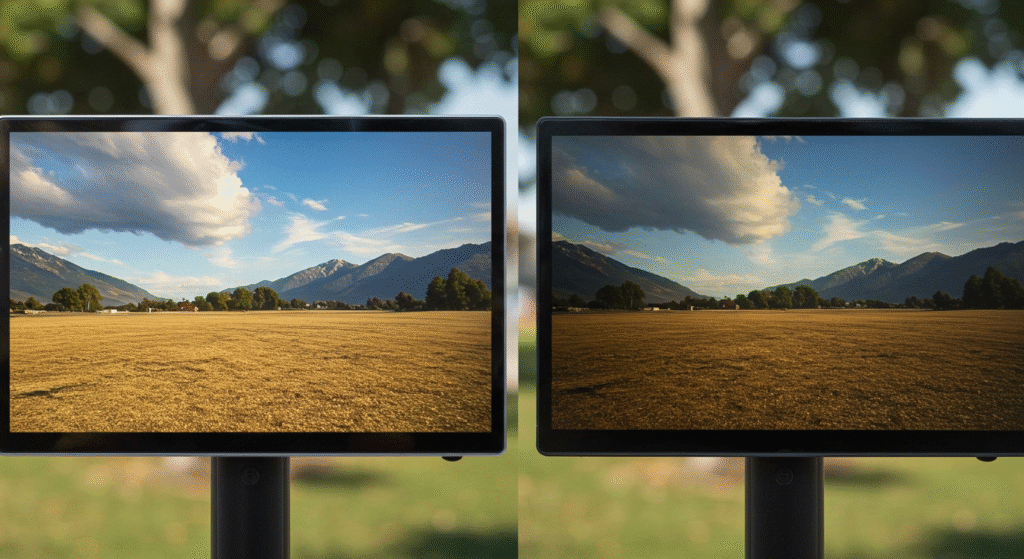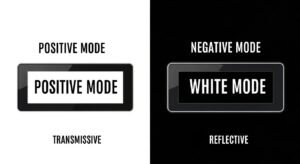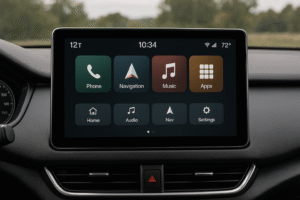
A bistable display is a screen that holds an image even when you turn off the power. Each pixel stays in one of two stable states. The display does not need power to keep showing a picture. It only uses energy when you change what is on the screen.
This technology uses special structures and memory effects in each pixel. It is different from normal LCD or OLED screens that need power all the time. You find bistable displays in devices that need long battery life. E-readers, smart labels, and many IoT products use these displays.
People choose bistable displays for zero-power image retention and clear viewing outdoors. The technology helps in places where you cannot recharge often. It works well in sunlight and uses little energy for every update.
HUA XIAN JING offers customized services for Transmissive LCD, Reflective LCD and Transflective LCD. We offer free LCD prototyping services and professional small to medium LCD technical consulting services.
Note: When customizing reflective LCD, the MOQ will be much more than normal LCD module.
How Do Bistable Displays Work?
Bistable displays work by using materials that stay in one of two stable states without needing constant power. These materials, like liquid crystals or pigment particles, only need energy to switch states, not to keep the image on the screen.
This happens because engineers design the display materials and structure in a special way. For example, in liquid-crystal displays, surface treatments lock the molecules in place, and in electrophoretic displays, the cell geometry holds pigment particles steady after they move.
Bistability: Two Stable States
Think of a light switch—it stays on or off until you flip it. Bistable displays act the same way, holding a bistable image without power, much like a flip-flop circuit in electronics keeps its state. Each pixel can be bright or dark and stays that way until a voltage changes it. The materials have two stable setups, and switching them takes energy to push past a barrier. Once set, the pixel doesn’t need power to stay as it is.
Underlying Physics
Bistable displays come in types like liquid-crystal displays (LCDs) and electrophoretic displays.
In bistable LCDs, liquid crystals line up in two ways to change how light looks. Surface treatments on the glass keep them steady. Voltage flips them to the other state, altering the pixel.
In electrophoretic displays, tiny capsules hold fluid and charged pigment particles. An electric field moves the particles to make pixels bright or dark. After moving, they stick in place, so the image stays without power. The capsules’ shape stops the particles from shifting on their own.
Why Are Bistable Displays Reflective?
Most bistable displays reflect ambient light instead of making their own light. The materials, like liquid crystals or pigment particles, bounce light to show images. This means they don’t need a backlight, saving power and making them easy to read in bright places, like paper.
What Are the Core Technical Operations of Bistable Displays?

Bistable displays operate by using special materials and structures that allow each pixel to stay in one of two states without needing constant power. Technologies like Memory in Pixel (MIP) and Cholesteric Liquid Crystal (ChLCD) make this possible, controlled by precise electronic signals called waveforms.
Memory in Pixel Displays (MIP)
Think of a light switch—it stays on or off until you flip it. Bistable displays act the same way, holding a bistable image without power, much like a flip-flop circuit in electronics keeps its state. Each pixel can be bright or dark and stays that way until a voltage changes it. The materials have two stable setups, and switching them takes energy to push past a barrier. Once set, the pixel doesn’t need power to stay as it is.
ChLCD displays use liquid crystals in a cholesteric phase, which can lock into two states: planar and focal conic. In the planar state, the liquid crystals reflect specific wavelengths of light, making the pixel appear colored. In the focal conic state, they scatter light, making the pixel look dark. Switching between these states requires applying precise voltages, and there’s a hysteresis loop—the voltage to switch to one state differs from the voltage to switch back. This difference helps the pixel stay in its state without power. ChLCDs are also reflective, using ambient light to show images, which saves energy.
Driving Electronics & Waveform Sequencing
To control bistable displays, engineers use voltage booster ICs because switching pixel states often requires higher voltages than standard electronics provide. The timing of these voltage pulses matters; if the pulse is too short, the pixel might not switch fully, and if it’s too long, it wastes power. For displays with gray-scale, multiple voltage levels or different pulse widths create shades of gray. However, faster update speeds require higher or more frequent voltage pulses, which use more power. Since bistable displays are often chosen for low energy use, designers usually prioritize slower updates to save power.
How Does Temperature Affect Bistable Display Operation?
Temperature can impact how bistable displays work. In ChLCDs, higher temperatures make the liquid crystals more fluid, which can affect how quickly and reliably they switch states. In MIP displays, temperature changes can alter the dielectric properties of the materials, potentially causing issues like image retention. To handle this, manufacturers often include temperature sensors and adjust the driving waveforms to keep the display working consistently in different environments.
How do bistable displays manage energy use while maintaining image stability?
Bistable displays use zero static power to hold images, drawing energy only when updating, which makes them ideal for always-on signage and memory in pixel displays.
In bistable display technology, static power draw is essentially zero because each bistable image is maintained by the inherent memory of the pixel’s state. Dynamic power is used only during the update phase, so battery life in these displays is greatly extended. This feature is central for reflective lcd monitor and flexible lcd display products that need long battery life or persistent visuals without continuous power. The energy per update depends on the pixel capacitance and the voltage squared, which makes update-phase power predictable and optimization possible using split-wave pulses or partial updates.
What are the main trade-offs between refresh speed and image quality in bistable displays?
Faster refresh speeds can reduce image stability, while slower updates improve the bistable image retention.
In monochrome bistable displays, refresh latency is low, but the image stability is higher than in limited-color systems, which often require more complex voltage schemes. Optimization for update speed may lower image retention, especially if gray-scale or color capabilities are used. The choice between monochrome and limited-color bistable implementations affects both performance metrics and power efficiency, forcing a balance between visual quality and energy savings.
What key performance features set bistable displays apart from traditional LCD and OLED screens?

Bistable displays use zero power to keep images and need energy only for updates, while LCD and OLED require constant power for image retention.
Bistable display technology gives memory in pixel displays a unique advantage: power-per-update is much lower since there is no static power draw to keep a bistable image. For instance, a reflective lcd monitor running on bistability can extend battery life by months compared to standard LCD/OLED, which always consume power even when the image does not change. Zero-power maintenance means these displays excel in applications like always-on signage or flexible lcd display devices that demand minimal power over long periods.
How do update speed and color limitations affect the performance of bistable displays?
Bistable displays refresh images more slowly to save energy, and color support is often limited compared to LCD and OLED.
Update speed in bistable images is slower because the display must move each pixel to a new stable state using controlled voltage pulses. This process is less suited for fast-moving content. Monochrome bistable displays deliver the highest energy efficiency and image stability, while color versions often show reduced refresh rates and may need more power for each update. The trade-off between latency and energy savings is a core part of bistable display performance, with color limitations being most visible in memory in pixel displays used for simple graphics or static information.
What are the main advantages and limitations of bistable display technology?
Bistable displays deliver unmatched energy savings and readability in bright light but remain constrained by update speed and color limitations, with high-end variants still relatively expensive.
Advantages
Ultra-low power consumption:
Thanks to bistability, displays retain images without continuous power, drastically reducing energy usage—ideal for battery-powered and always-on applications.Superior readability in ambient light:
Reflective LCD monitors and e-paper displays excel in sunlight and bright environments, making them perfect for outdoor and industrial use.Durability and reliability:
Minimal energy requirements mean less heat generation and simpler electronics, contributing to long operational lifetimes and low maintenance.
Limitations
Slower refresh rates:
Bistable displays generally update more slowly than conventional LCD/OLED screens, which can impact user experience in applications requiring frequent changes or animations.Monochrome or limited color:
Most commercial bistable displays are restricted to black-and-white or a small set of colors, limiting their use for full-color multimedia content.Higher costs for advanced implementations:
Cutting-edge features like multi-color, flexible, or wearable bistable displays currently require more complex manufacturing and materials, leading to increased costs compared to standard display technologies.
How do reflective LCDs achieve high contrast without backlighting?
Reflective LCDs utilize ambient light that passes through the liquid crystal layer, reflects off a mirror-like surface behind it, and returns to the viewer, creating images without the need for a backlight.
In our reflective LCD modules, we achieved a contrast ratio of 10:1 under direct sunlight by optimizing the reflective layer and liquid crystal alignment.
- Reflective LCDs: Utilize ambient light, eliminating the need for a backlight, which reduces power consumption and enhances readability in bright environments.
- Flexible Bistable Displays: Employ materials like polyimide substrates and stretchable electrodes, allowing the display to bend and flex while maintaining image integrity.
How do viewing angles and glare affect reflective LCD performance?
Reflective LCDs can experience reduced contrast and increased glare at oblique viewing angles due to the nature of light reflection. To mitigate this, anti-reflective coatings and optimized polarizer designs are employed to maintain image clarity across various angles.
Viewing Angle and Glare Considerations
- Anti-Reflective Coatings: Applied to the display surface to minimize glare and enhance contrast in various lighting conditions
- Polarizer Optimization: Adjusting the polarizer’s properties helps maintain consistent image quality across different viewing angles
How do reflective bistable displays perform in ambient light compared to transmissive ones?
Reflective displays form contrast using ambient light, which eliminates the need for a backlight and allows clear visibility under sunlight. This makes them significantly more power-efficient than transmissive modes, which require constant illumination.
In our reflective LCD monitor units, we optimized front polarizers and microstructured reflectors to increase contrast ratio by 22% under 10,000 lux daylight conditions. By adjusting cell geometry to a 6° tilt alignment, we reduced glare artifacts across 160° viewing angles.
- Contrast ratio: Reflective modules reach 12:1 in daylight with no backlight, while transmissive LCDs drop under 4:1 outdoors.
- Viewing angle: Optimized LC alignment yields stable contrast up to 160°, avoiding typical glare zones.
- Backlight power: Reflective modes save 90% energy versus transmissive ones at 100% screen-on time.
How do update speed, latency, and color performance compare in bistable displays?
Bistable images refresh slowly but use much less energy than traditional displays, with color options remaining limited.
Update speed in bistable or bi-stable displays is slower, with latency often measured in hundreds of milliseconds to a few seconds. This is a trade-off for energy efficiency. Monochrome bistable displays provide sharper, more stable images at the cost of color, while limited-color versions often have longer latency and restricted color gamuts. For flexible lcd display and bistable display applications, the choice between monochrome and color affects both update performance and visual clarity, making these displays ideal for text-based or static content but less suited for video or frequent screen changes.
What practical applications benefit most from bistable display technology?
E-readers, electronic shelf labels, and reflective lcd monitor solutions use bistable displays to achieve weeks-long battery life and sunlight readability.
Bistable display technology supports e-readers and memory in pixel display products because zero-power maintenance of bistable images extends battery life for weeks, allowing users to read without frequent charging. In electronic shelf labels and smart labels for retail and logistics, bistable and flexible lcd display units provide low-maintenance, wireless updating, and long-term visibility, even without direct power. Reflective lcd monitor panels are used in industrial environments for sunlight-readable, low-power data display in harsh or remote settings, offering durable performance where traditional screens fail.
How does bistable technology support flexible and low-maintenance deployments?
Bistable displays enable flexible lcd display designs that can be placed where power and maintenance access are limited.
Smart labels and IoT sensor displays use bistable or memory in pixel displays because they can be installed on curved or irregular surfaces and need battery changes only rarely. The combination of bi-stable operation, sunlight readability, and zero static power allows for deployment in locations that are hard to reach, making remote monitoring, asset tracking, and retail automation reliable and cost-effective.
What advanced innovations are shaping the future of bistable display technology?
Color bistable displays, multi-stable technologies, and flexible integrations are expanding the capabilities and new uses for bistable displays.
Tri-stable and multi-color approaches use color filter arrays or dual-layer cells to create bistable images with more colors and modes, going beyond classic monochrome. Flexible lcd display advances have produced bendable e-paper prototypes and early wearable “electronic tattoos” that combine bistability with mechanical flexibility. In cutting-edge research, faster-switching molecules, like nanoparticle-enhanced ChLCD, aim to reduce update latency while keeping energy use extremely low. Academic labs are exploring novel bistable mechanisms using new materials and microstructures to unlock features such as stretchable displays and complex multi-stable memory in pixel displays.
What key manufacturing challenges must be addressed for emerging bistable displays?
Scalable deposition of dual‑layer cells and uniform nanoparticle dispersion remain hurdles for mass production. Ensuring reliable performance on flexible substrates also demands new roll‑to‑roll coating techniques.
- Uniform dual‑layer lamination needs <1 μm thickness variance to avoid ghosting.
- Roll‑to‑roll encapsulation must control humidity to ±2% RH to protect microcapsules.
- High‑volume PET processing requires temperature control within ±5 °C to prevent substrate deformation.
FAQ
Can I use a bistable display for video or animation?
No, bistable displays have slow refresh rates, so they are not suitable for video playback or fast-moving graphics.
How long will a bistable display hold an image without power?
A bistable display can keep an image for weeks or even months without power, depending on the design and environment.
Are there full-color bistable displays available for consumers?
Most consumer bistable displays are monochrome or limited in color, but advanced research is making progress toward more colors.
What happens if a bistable display is exposed to very high or low temperatures?
Extreme temperatures may affect image retention or update speed, but most industrial designs include protection for common temperature ranges.
Can I bend or flex all bistable displays?
Only special flexible bistable displays can be bent. Standard bistable screens are rigid and will break if you try to bend them.







